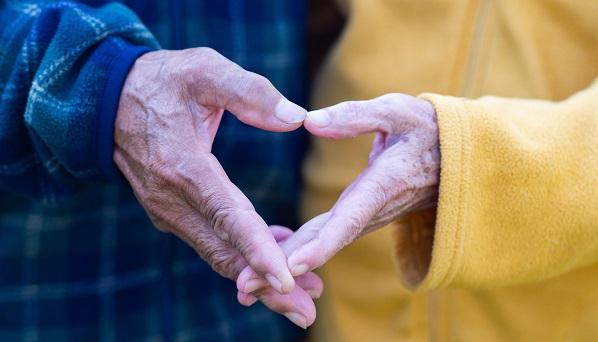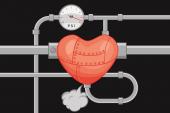LVADs Can Be ‘Transformational’ for Elderly HF Patients
Survival of those older than 75 has increased over the years, thanks to a mixture of better devices and patient selection.

Left ventricular assist devices (LVADs), particularly the latest iterations, can greatly increase functional capacity and quality of life for patients with heart failure, more than a decade’s worth of US data show. Even people older than 75 stand to gain these benefits.
For these eldest individuals, researchers found a significant improvement in 3-year survival over time, rising from 43.0% of those treated in 2010-2012 to 46.3% during 2013-2016 and then 55.7% during 2017-2020.
Dominic Emerson, MD (Smidt Heart Institute at Cedars-Sinai, Los Angeles, CA), told TCTMD the most important takeaway from the study is that older patients “not only do as well for the most part as younger patients with these devices, but in some ways they actually seem to tolerate them much better than what conventional wisdom would be.”
Approximately 6 million people in the United States have advanced heart failure, Emerson and colleagues point out in the Journal of the American College of Cardiology. But out of their nearly 25,000-person data set, the proportion that were elderly was just 5% and didn’t shift over the study period, which the investigators say suggests that LVADs may be underutilized.
Speaking with TCTMD, co-author Joanna Chikwe, MD (Smidt Heart Institute at Cedars-Sinai), said this disconnect may be due to “lack of awareness about how much better the outcomes are now than they were even maybe 5 years ago with the older generation of LVADs,” such that there’s a reluctance to refer patients for the therapy.
The changes in quality of life and 6-minute walk test they saw here, Emerson said, are “sizeable,” indicating that patients “had really meaningful time added to their life.”
He emphasized: “It’s one thing to say that an intervention can improve the longevity of an individual, but it’s another thing entirely—and I think a very important thing to consider—whether they’re getting back to a good quality of life, whether they’re getting back to the things they want to do.”
Chikwe and Emerson said they hope to draw clinicians’ attention to the idea that durable LVADs can be a good option, especially for older patients who may not be candidates for heart transplantation due to their age.
Fewest Complications in the Eldest Patients
Using the Society of Thoracic Surgeons INTERMACS database, the researchers identified 24,408 adults (78% men; 66% white) who received a durable LVAD between January 1, 2010, and March 1, 2020. Among them, 68.9% were younger than 65, 26.3% were 65 to 75 years old, and 4.8% were older than 75. The predominant etiology was dilated cardiomyopathy, seen in 90%. Four in five patients were classified as NYHA class IV, 35% had experienced progressive decline, and 35% were stable on inotropic support at the time of LVAD implantation. For 51%, it was a destination therapy, while 27% received a device as bridge-to-candidacy and 22% as bridge-to-transplant. Median follow-up was 15 months.
By 5 years, an estimated 33.5% of patients younger than 65 had died, compared with 54.4% of those 65 to 75 and 66.2% of those > 75 years. Most complications, however, went in the opposite direction, such that the highest risks of stroke, device malfunction or thrombosis, and rehospitalization were seen among the youngest patients. Bleeding, though, was least common in those below 65 years and most frequent in those ages 65 to 75.
Early mortality within 3 months was independently predicted by dialysis in the 48 hours prior to LVAD implantation (HR 3.41), preoperative critical cardiogenic shock (HR 2.85), major stroke (HR 1.82), and female sex (HR 1.77). Late mortality after 3 months was higher in conjunction with a major psychiatric diagnosis (HR 1.74), limited social support (HR 1.55), and frailty (HR 1.29).
Newer-generation LVADs with continuous-flow full magnetic levitation were tied to fewer deaths over the long term (HR 0.35; 95% CI 0.25-0.49) compared with older devices.
These latest designs “reduce wear and tear,” Chikwe explained. “They seem to be less thrombogenic, so there’s much lower risk of pump thrombosis and blood clots, which obviously can cause stroke. And you [can] anticoagulate less aggressively, so there’s less risk of major bleeding, and they seem to be less prone to chronic infections.”
Around half (51.6%) of study participants completed quality-of-life surveys, and among them, 57.7% did so at 1 year. The researchers gave patients who cited “too sick” as a reason not to reply the lowest possible score when calculating their results. On a visual analogue scale from 0 (“worst health”) to 100 (“best health you can imagine”), the median score rose from 40 preoperatively to 75 at 1 year. All age groups reported equally strong quality-of-life gains.
For 6-minute walk test, participation rates were 21.1% at baseline and 38.7% at 1 year. Again, those “too sick” to take part were considered to have the worst possible result. Overall distances rose from a median of 0 feet preoperatively to 1,065 feet by 1 year. The greatest change was seen in the youngest patients (774 feet) but distances also lengthened significantly for those ages 65 to 75 years (540 feet) and those above 75 years (456 feet).
Careful Selection and Meticulous Management
Joseph G. Rogers, MD (Texas Heart Institute, Houston), commenting on the registry findings for TCTMD, said they confirm positive shifts in the field. “What we’ve learned over time is to be very thoughtful in the selection of our older patients who go on VAD therapy, so it’s not surprising to me that this cohort did pretty well,” Rogers observed, adding, “What I think it suggests is advanced heart failure physicians and surgeons have begun to really discern who it is that’s likely to do well in an older patient [population].”
Any cardiologist that is confronted with a much older patient who’s aged out of transplant and has advanced heart failure does need to know that this is a potentially transformational option for that population. Joanna Chikwe
As for what led to the survival gains, Rogers credited not only evolving devices but also improving care. “I like the argument that they put forward that the older population has less resilience to tolerate major adverse events, so I think that’s a really important concept [addressed by] the new technology,” he said. “But I also don’t think that we can discount this idea of improvements in patient selection as another important part of it.”
In an editorial, Francis D. Pagani, MD, PhD (University of Michigan, Ann Arbor), agrees that “these data in total confirm the benefits of durable LVAD therapy in a selected population of elderly patients.”
Quality of life and functional capacity are essential attributes of therapy directed at this population, “who do not have transplantation as an alternative or ‘bailout’ strategy if quality of life were not to improve,” he writes, noting, “Although living longer is an important goal of any advanced therapy, living well has equally profound implications.”
Chikwe said that the outcomes seen here stemmed from “careful patient selection and meticulous management at experienced centers.” Frailty and cognitive function, for instance, are factors that might deter LVAD implantation, she noted. “But patients in their late 70s that are functionally much younger in spirit: those patients do extremely well with this therapy, and those are the patients that are not really eligible for heart transplants at most centers.”
Rogers noted that many things factor into whether patients will do well on LVADs. Beyond frailty, there’s also the question of whether they have a support team, he said. “One of the challenges we face in an elderly population is that a lot of those individuals have elderly spouses.”
Resilience is required, stressed Rogers. “This is a major cardiac surgical procedure that’s being performed . . . , and to add to that it’s an elderly patient population that comes into the operating room with a reasonable amount of comorbidity, because most of these individuals have been living for a long time with chronic heart failure. So they’re physically debilitated, they’re nutritionally debilitated, a lot of times they’re emotionally debilitated.” The acute recovery period can be challenging, he added.
The improvements seen in this data set are positive news, said Rogers, but “I’m still not sure we’ve achieved our full potential.” Much needs to be learned about management after LVAD implantation “in the immediate term but more even in the long term,” he commented. “So I think we should be investing a significant amount of our collective energy as clinical investigators” to explore best strategies for blood pressure, anticoagulation, and cardiac rehabilitation.
How Much Undertreatment Is There?
Rogers said he wasn’t convinced, though, that underutilization is a widespread problem. Certainly there are patients in the US and around the world “who are candidates for LVAD therapy, who would benefit from LVAD therapy, and who don’t get offered the treatment,” he agreed.
That said, those numbers haven’t been pinned down, Rogers noted. “Everyone wants to know—the companies want to know, investors want to know. But it’s complicated, and trying to estimate with any kind of granularity how big that patient population is [of] good candidates is tough,” he cautioned. Moreover, there are some people for whom an LVAD may not be the best choice, even if they are eligible, thanks to an interplay of risk factors.
Going forward, Emerson said, the researchers hope to explore barriers to referral and utilization of these devices, which vary by geographic region and demographic factors. “Understanding the drivers of that so we can more equitably offer this technology is important,” he stressed.
What would shift the paradigm for older patients is fully implantable LVADs, ideally models that could be inserted percutaneously, said Chikwe. “We’re obviously a little way away from that, but that’s going to be the biggest driver of expanding the patient pool that can benefit from this.
“But in the meantime, any cardiologist that is confronted with a much older patient who’s aged out of transplant and has advanced heart failure does need to know that this is a potentially transformational option for that population,” she concluded.
Caitlin E. Cox is News Editor of TCTMD and Associate Director, Editorial Content at the Cardiovascular Research Foundation. She produces the…
Read Full BioSources
Emerson D, Chikwe J, Catarino P, et al. Contemporary left ventricular assist device outcomes in an aging population: an STS INTERMACS analysis. J Am Coll Cardiol. 2021;78:883-894.
Pagani FD. Is durable left ventricular assist device therapy a viable option for the elderly? J Am Coll Cardiol. 2021;78:895-897.
Disclosures
- The Society of Thoracic Surgeons funded and designed the data analysis, which was performed at the University of Alabama at Birmingham Data Coordinating Center.
- Emerson and Chikwe report no relevant conflicts of interest.
- Pagani has served on the scientific advisory board of FineHeart.





Comments